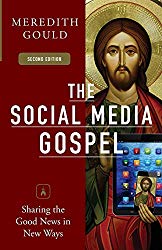Yesterday’s worship service focused on our responsible use of social media. Here is a review of a book that reminds the church how we might use such media in a positive way. Click here to read yesterday’s sermon, “A Light in the World”

Meredith Gould, The Social Media Gospel: Sharing the Good News in New Ways, second edition (Collegeville, MN: Liturgical Press, 2015), 180 pages, index and notes.
This easily read book encourages churches to support social media as a way to expand their communication and outreach. Sadly, it is four years old. The digital world is rapidly changing as new venues come online and changes are made to existing ones. The author, a committed Roman Catholic, writes for an ecumenical audience. She often quoting those from other Christian traditions. The forward for this edition is even written by the Reverend David Hansen, a Lutheran pastor in Texas.
The book consists of three sections with a number of helpful appendixes. In the first section, which I found most helpful, she debunks the idea that social media destroys community. Instead, it creates new types of communities. She also has a brief chapters on generational differences, learning styles, and personality types. She helpfully points out that what one person finds annoying could be what draws another person into the community (22). Such a reminder is helpful, for it is too easy to let the most outspoken critics drive us, which often leading to inefficient efforts that fail to accomplish anything. A little grace by all of us goes a long way toward accomplishing the church’s mission.
Gould provides an interesting take on the old 80/20 rule. She suggests that 80% of our content on social media should be about building community and only 20% to be about promoting and reporting on the news of the organization. I have heard similar ideas from several other sources writing about business use of social media, one of which suggested that you try to build up your reputation (or brand), offer five helpful solutions for every “sales pitch” you make. A second interesting “rule” (which she credits to Jakob Nielsen) is the 90/9/1 Rule. 90% of the people observe your social media presence, 9% occasionally participate by commenting or interacting, and 1% dominate by providing most of the content and comments. She suggested the 1% are important for they are our ambassadors/evangelists, but that we also don’t forget that we may be reaching a lot more people than those who participate. (26)
There were a number of other gleaming I found helpful in Gould’s opening section. She suggests that technology provides a means to prepare people for the sacraments, but it does not replace or provide the sacrament. (10) There is still need for real presence within the community. I also found it helpful how Gould describes the development of online communities. Online, things move approximately three times faster than in the real world. People engage much quicker and they also stay engaged shorter periods of time than they might in the face-to-face world. (31)
The second section of this book offers guidelines into developing a social media strategy and provides a basic overview for top mediums of social media: blogging, Facebook, LinkedIn, Pinterest, Instagram, Twitter, YouTube, Snapchat. For each of these groups, she provides suggestions on ways the church might use them to further its mission. While she does not suggest that the church attempt to use all of these mediums, but to pick those which would best for the church’s situation (there are helpful questions that can guide such decisions), she is a big fan of Twitter. While she doesn’t suggest that Twitter is for everyone, she tells of her “conversion.”
The final section of the book is titled “Making Social Media Work.” There are several helpful chapters here that focus on how social media can be integrated into a church’s communication strategy, how to develop content (and share it on multiple platforms), handling burnout, best practices for social media use and how to handle online conflict. As for creating content, it needs to be short (according to her suggestion, this review is about 250 words longer than it should be J).
While I found parts of this book dated and a little elementary, Gould provides useful tools to help congregations discuss this new world in which we live. And, as for it being elementary, I must remember that may not be the case for everyone. After all, I’ve had a blog for over 15 years, have served churches with websites for 25 years, and have been on Facebook for nearly a dozen years. Others may find this book to be right at the level as they began engaging in this new online world.

We could all use reminders and teachings on responsible use of social media. Highly relevant info.
I hope you’re enjoying the holiday weekend.
…she debunks the idea that social media destroys community.
From my observations social media does create more than it destroys. The main trouble though is that all the cranks and crazies tend to get noticed far easier than everyone else sharing peaceful and rational ideas.
I freely admit I’ve thrown a few cyber-grenades (unhinged rants) in my years of blogging and posting on Facebook. But many people do in fact keep their humanity, a little fact many overlook.
I must say I’ve never given it too much thought – the role of social media in the spiritual world – which is perhaps not good, seeing as our day to day world is everything to do with social media – or so it would seem for many.
I for one do appreciate quiet, reflective moments.
All the best Jan
PS It was very interesting to read Meredith’s reply to your post.
Thank you for well written review.
My understanding that social media could reach more audiences and reach any part of the world than traditional ones.
May God bless you.
These are good tips for using social media. I didn’t realize that 90% of viewers don’t respond to posts on social media, yet they see them.
Very interesting to think about the role of social media in the spiritual world. Obviously, I don’t spend nearly as much time in that sphere as you. So much of what one sees in mass media is the dangers: social media as the pathway to narrow-mindedness and even fundamentalism. But of course, there is also the capacity for good.
I’ll be interested to know how/if you use what you have learned.
She’s right with that we do reach a lot more people than we think or with who communicate or interact with our posts on social media. I was just talking to someone on Twitter about that the other day. A lot more people see the stuff we put out there than we think.
Thanks, Jeff, for your review and especially for letting me know you posted it. I have a couple/few comments:
1) Yes, 4 (!?!) years old but knowing how swiftly platforms change, I specifically focused primarily on distinguishing strategy from tactics and then choosing tools (i.e., social media). That content is evergreen. Having logged 20+ years in church communications consulting, I found–and still find–that thinking strategically and tactically is still missing from the process.
2) If I were to update this book–unlikely because of changes at Liturgical Press–I’d note which platforms are now defunct and explain why. Plus I’d write a chapter about cultural norms that have emerged during the past decade.
3) For all the whimpering and whining about FB, it’s still essential for churches. So is Instagram IF the congregation is trained/encouraged to become “Brand Ambassadors.” Twitter is a total waste of time for institutional accounts.
4) Weakest link of all of remains the website. Anything developed more than 12-18 months ago is now obsolete for several technical as well as online readability issues. Church and nonprofit leadership almost puke when I say this.
5) I’m not a committed Catholic but charmed that you–or anyone– think I am!
For what I’m doing these days, visit my mosaics website!
Thank you for replying. I always try to let authors know when I review their works. I am glad to hear your thoughts here on Twitter for institutions, for it’s a medium I have never fully understood but know others who swear by it. As for websites, while they may be less effective for reaching people, I think they are essential for its what many people first see about a church (instead of the yellow pages of 20 years ago, folks go to the website). And maybe I overstated your commitment–I probably should have said you were writing out of the Roman Catholic tradition but for all denominations. I am glad you didn’t take offense. I appreciate your thoughts on strategic thinking when it comes to communications for too many people think if we just had nicer signs, a cleaner logo, a better website, etc, it’ll all be paradise! Blessings on your future endeavors.
I’m far more familiar with some forms of social media than others and not everyone uses them all, so I’d love for my church to branch out beyond FB (which I don’t use). This sounds like it could be a useful tool. Better to err on the side of simplicity, in my opinion.